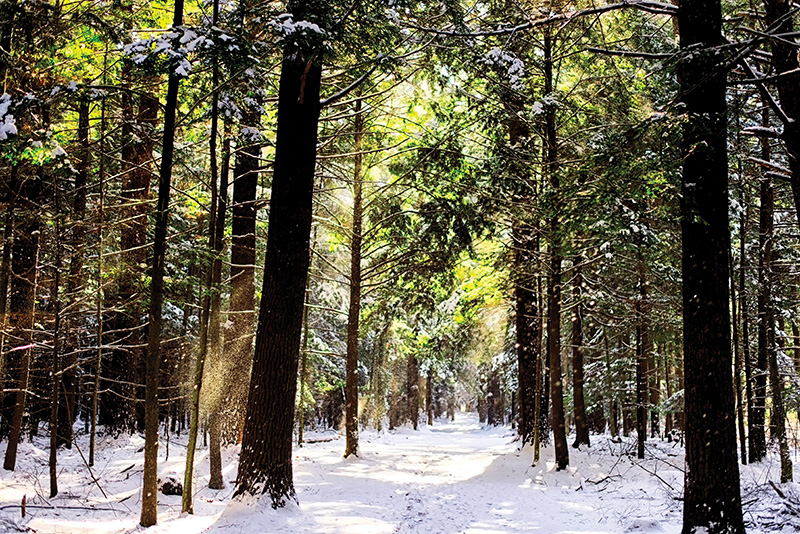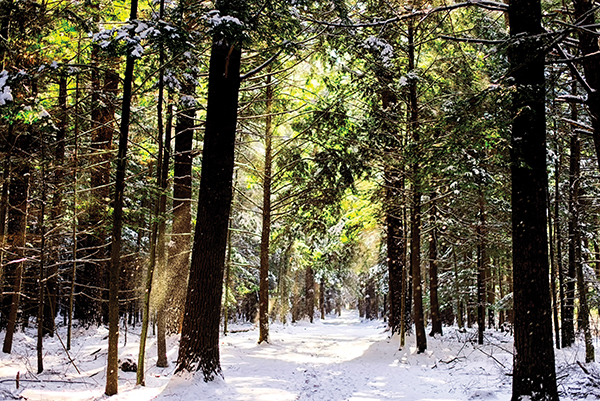
A Century Ago, Odell Shepard
Fell in Love with New England
By Paul Spitzer

Image Credit: Getty Images/Daniel Hanscom.
This teacher, scholar, poet, and wayfarer was an editor and emulator of Thoreau.
When I was a 1960s student at Wesleyan, I came across The Heart of Thoreau’s Journals—gracefully edited by Trinity College English professor Odell Shepard and originally published by Houghton Mifflin Company (HMCo), in 1927. My 1961 Dover paperback reprint provided spiritual and philosophical guideposts for my own youthful development as an ecological scientist. Over several decades, the book survived in my now immense book collection, and Shepard’s authorship was still lodged in a remote corner of my mind (I am a librarian’s son!).
Fifty years later, in my now-long life and travels as a professional ecologist, I once again encountered Prof. Shepard—this time as a poet and wayfarer, a very happy “sauntering” disciple of Thoreau. While Thoreau “traveled widely in Concord,” Shepard chose much larger portions of rural Connecticut for his impassioned rambles. He shared his footloose adventures, impromptu ecstasy, and lavish praises in The Harvest of a Quiet Eye, also published in 1927 by HMCo. A century later, in our far more mechanized, hurried, and crowded world, Shepard’s happiness, discoveries, and epiphanies shine out from his walking journal. He shares his physical and spiritual freedom in the hills, forests, streams, and small towns of Connecticut. He has fallen in love with the land and its people.
I suggest (and fervently hope) that we can still do the same. Given many trends of modernity, Shepard offers some very healthy prescriptions. Having recently survived certain antiquated short entrance ramps on the too-high-speed and crowded Connecticut Turnpike—and the epic daily jams on the forested Merritt “Parking Lot”—I am listening carefully to what Shepard figured out a century ago. Our options are somewhat different, but resources for humanistic “Habitat Selection” in nature are still there: preserves, trail systems, quiet ridgeline vistas, visionary land trusts, and rural roads where quiet Thoreauvian “sauntering” should still be an option. Sometimes with a dog on leash or a baby carriage. Also, as one proceeds north in New England, the possibilities for such freedom rapidly increase. Hill and mountain country offers sanctuaries; and one can usually figure out ways to walk downhill. Shepard always gives his gradual descents into small valley towns—and his encounters with the locals—an element of theater. Anyone who has walked down a secluded stream valley that terminates at a river and busy highway can relate to this. In modern times, I empathize with deer and bears—feeling a similar impulse to flee my sudden, unplanned encounter with human noise and traffic.
But how did Shepard achieve his poise and happiness? What was his own personal genesis? He was a minister’s son, so he probably learned lessons about access to grace and serenity. Raised in Illinois, he earned two degrees in 1907 and 1908 from the brainy, progressive University of Chicago—but his restlessness in urban environments is a recurring theme throughout his writing and his life. (Eventually, he would use a secluded streamside Connecticut cabin to escape from Hartford.) In 1909 this young man went west, teaching English literature in southern California (USC) until 1914. Then came his big fateful move east across the continent, gaining a PhD in 1916 at Harvard. He became a committed, lifelong New Englander. This included Thoreau’s distrust of materialism. Following the stock market crash of 1929, writing in the Trinity Tripod student magazine of February 18, 1930, he encouraged a “greater appreciation of the spiritual side of New England”! This is minister-style hortatory advice in business-oriented Hartford, Connecticut! (His sympathetic—and like-minded?—Boston publishers at Houghton Mifflin were to publish Roger Tory Peterson’s first rudimentary Field Guide to the Birds in Depression-era 1932—the rest is history!)
Shepard was prolific: There are several books, including a biography of Bronson Alcott, which won a Pulitzer Prize. Alcott, a close associate of Thoreau and Emerson, was noted for his rather unworldly idealism and also as father of Louisa May Alcott, the famous author of Little Women. The May 6, 1938, Trinity Tripod contains a long laudatory article about Shepard’s many accomplishments. He goes on to serve as a wartime lieutenant governor in Connecticut, 1941–43; a Rooseveltian New Dealer, I think. He believed in the idealism of the American people. He had faith in self, man, and nature, and questioned conformity, timidity, and docility. He also celebrated both solitude and “Sense of Place,” as we read in Quiet Eye.
Eventually, in the post-war Connecticut boom and zeitgeist of 1946, Hartford businessmen forced his retirement after thirty outspoken years (walking to Thoreau’s “different drummer”?) on the Trinity faculty. I think he then lived quietly for twenty more years on Jordan Cove in Waterford, Connecticut, where he focused on local Connecticut history. He wrote about the ancient (1678) Joshua Hempsted House in New London, and Hempsted’s diary of 1711–1758. I have an intimate knowledge of that historical house, because my mother, Virginia Randolph, served as its live-in curator for several years. I never encountered ghosts during my quiet sleepover visits. The Connecticut coast of the ‘50s and ‘60s would have spoken to the poet Shepard—as I know, from my formative years spent there. I wish I could have visited Odell when I was a young student. I was born too late for that—but not for his written inspiration, sending me on time-travel to the Connecticut of a century ago. One hundred years later, a paperback reprint of his The Harvest of a Quiet Eye might provide spiritual and cultural perspectives for our times and the future.

